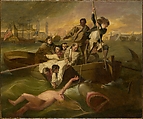Watson and the Shark
John Singleton Copley American
Copley painted this rapid study for "Watson and the Shark" from his first rendering of the iconic work—now in the National Gallery of Art, Washington—in preparation for successive versions, found in the collections of the Detroit Institute of Arts and the Museum of Fine Arts, Boston. It depicts the future Lord Mayor of London, Brook Watson, who, as a teenager, lost his leg to a shark while swimming in Havana harbor in 1749. A Black sailor forms the apex of the composition, holding a rope for the victim who later famously defended the slave trade in the West Indies. Copley’s dramatic depiction of an ordinary man in the midst of an extraordinary event of unresolved peril in the Atlantic World revolutionized British-American history painting.
Due to rights restrictions, this image cannot be enlarged, viewed at full screen, or downloaded.

